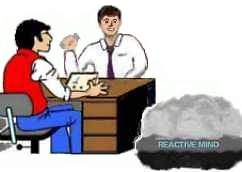ARC and Training Routines |
||
|
An important part of becoming a professional auditor is mastering the Training Routines (TR's), which are the drills for the communication formula. It is however necessary to see how the drills fit into the whole picture. Here we will first cover ARC and TR's. Then we will cover the main Axiom the TR's are based on: Axiom 28, the Communication Formula. Without a good understanding of the inter-relation between Communication and Reality, Communication and Affinity and Communication and Understanding the whole subject of TR's can take a completely wrong direction. The TR's purpose is to improve the student's live communication.
In other words: for auditing to occur we need live communication.
'Improved communication' without the A and R being improved is just not live communication and has no place in TR's. Let us quickly repeat what A, R and C are:
How these three points of A, R and C interrelate can be seen in some examples.
There must be good affinity, some affection, between two people before they are very real to each other. Reality between people, as we talk about it here, must be seen as a gradient - a scale, where some things are more real than others. There must be a good affinity between two people before they can talk to each other with confidence and any truth. They start with a little affinity and build it up, gradiently Before two people can be real to each other there
must be an interchange or communication between them. They must at least
be able to see each other or hear each other to have a live communication.
Just seeing each other, perception, is a form of communication by the way. So there is an interdependence, a close relationship, between these three factors of A, R and C. When one drops the two other ones drop as well. But also, when one rises the two other factors rise with it. That means if you work to improve one corner of this triangle, the two other corners will improve with it. If you work on two corners the third corner will automatically follow.
These three points also hang together when it goes the other way. If one of them drops, the two others will also drop.
"Good Roads Fair Weather" This is a true story. A young girl had run away from home as the relationship with her parents had become so bad so the parents wouldn't talk to her. The girl had taken a job in an office. She seemed quite unhappy and depressed and she wasn't doing well at her job. An auditor was asked by the office manager to see if he could help the situation. The auditor gave the young girl an interview and found out, that the parents were very angry with her and refused any communication with her. They were upset with her because she had refused to follow the career as a concert pianist that they had envisioned for her. In fact, such a career was beyond her ability. They had spent a lot of money on her studies, that had come to nothing. So they "washed their hands" of her and this unhappy situation had forced her to run away from home to live in another city. Since the break they hadn't communicated with her at all, but from people in her home neighborhood she knew they were disappointed and felt bitter about her. Since she had been closely attached to her parents the break and separation had a deep effect upon her. She couldn't do her work properly. Her failure at work was jamming the communication lines of the office and the office manager was concerned. She liked the girl, but her poor performance had to change or she (the office manager) had to fire her. Usually the girl would simply have been fired, but help was hard to find and the office manager had a better idea. She asked the auditor to help. The auditor knew his A-R-C Triangle well and he knew exactly what to do. It seems very simple, but it had a magical effect. He simply told her she had to write her parents - whether she would get a reply or not. And so she did. Naturally she didn't get a reply. Why didn't the parents reply? It is simple. The girl had disobeyed them and had refused their advice and control and they had cut off all contact. To the parents she wasn't very real at this point. They more or less denied her existence as far as they were concerned. They had actually tried to 'forget her' and erase her from their lives due to their big disappointment. Therefore their emotions had come to a point of apathy towards her. They had been unable to control her and this failure made them apathetic in regards to her. It had also made her unreal to them. Actually, as they had started her on a career she didn't have the talent for, she couldn't have been that real to them to begin with. The auditor had her write a letter. This letter was "good roads and fair weather". Just simple, good news about herself. She said she was working in another city, that the weather was fine there and she was doing all right; she hoped they were both well and sent them her love. The auditor had instructed her carefully not to mention any of the events before leaving home or anything else that could open old wounds. The affinity, the A, of the letter was quite high. The C was of course there. What the auditor really wanted to accomplish at this point was to establish the R, the reality. He wanted them to get used to the idea that she actually existed; that she lived in another city and took care of her own life. She wrote several letters like that without getting an answer. The auditor instructed her to just stay with the "good roads and fair weather" subjects and tone. He was simply trying to establish the R. Since she in her earlier life had depended so much on her parents the present situation had caused her to see her whole existence as unreal and flimsy. After about four letters along these lines, each letter carefully written in an optimistic and positive tone with little attention to not getting any reply, there suddenly was a letter back from her mother. The mother expressed anger, not against her daughter but against one of the girl's old friends. The auditor instructed her carefully not to express anger in her reply, but instead write in pleasant surprise how happy she was to hear from her mother. After her letter two replies came; one from her father and one from her mother. This time they were both affectionate and they hoped the daughter was doing well. The girl naturally wanted to reply to these positive letters. The auditor of course let her do so. Without his intervention her replies would however have been very propitiative. He instructed her to send two happy letters, one to each of her parents, and just be lighthearted and positive. In this way the auditor kept repairing the break between the daughter and her parents. He was using communication and the ARC triangle. When this relationship was well repaired the girl felt a lot better about herself and doing her job. The parents had now understood that she had chosen a job she could manage; and having their blessing (reality) meant that she could take pride in doing it (affinity). As a result her willingness to communicate with her colleagues and her tasks rose markedly and she started to become a real asset to the office. So we see the ARC triangle and the tone scale in action in these examples and in just about any situation in life. What we saw the auditor do, in the example with the young girl, was to control her communication to her parents, knowing well that he had to pay close attention to the two other points of the ARC triangle to make it successful. The Tone scale and Communication In the sub-apathy band (0 to -40 of the expanded tone scale) the individual is not really communicating at all. It's some social response or training pattern or mental 'circuit and machinery' that is communicating. From the scale it is obvious the affinity is at its lowest. But so are the two other factors of the ARC triangle, including the communication. In TR's there is a phenomenon known as 'Robotic TR's'. That is a dreadful condition where the student by lack of understanding of the basic theory of ARC and TR's and through bad coaching has developed 'TR's' that sound like a voice mail recording. "Press one, if you want the auditing command repeated", "Press two, if you want an acknowledgement", "Press three if you want your origination handled".
The person himself does not really seem to be there and he isn't really talking. Therefore his communication is strange to say the least. What's missing is live communication. There is no ARC. When a person is stuck in any one band of the tone scale he voices communications in that emotional tone.
They are better off than somebody in sub-apathy, but they can still be unpleasant to be around. From a more causative viewpoint, how would you talk to people? It is clear if you were stuck in the sub-apathy band you wouldn't be able to talk to anybody. You would have to have more affinity than that to discuss things with anyone. Your ability to talk to any specific person would have a lot to do with your emotional response to that person. It is clear if somebody didn't care about a person (low affinity) it would be very difficult to talk to them. The way to talk to somebody is then to find something you like about him or her and to discuss something you can agree on. Things you agree on are more real. Reality and agreement in terms of ARC are closely connected. In a group of three, the one that didn't agree with what was being said would soon become unreal to the other two and his affinity would be seen to drop. There is one thing you have to realize about ARC and communication. If the person starts out in apathy about you, he will have to come through fear (being afraid of you) and anger (being angry at you) to make progress. Especially the expression of anger can be puzzling to the untrained person. You just have to realize, that you have done tremendous progress towards establishing a better relationship. It will still have to go through antagonism and boredom as well before you can expect real interest to surface. To be a good communicator one also have to really listen to what people have to say and acknowledge what they say. The acknowledgment helps establish the reality. An acknowledgment is not necessarily an expression of agreement. But a person that realizes he has been heard and understood does feel he has made his point and his reality has been received. So the acknowledgment does have to express affinity and understanding. We have a particle or impulse. It can be a letter, an e-mail, a gift, or even a blow or a bullet, or simply spoken words. When an understanding is transferred from one being to another by the means of a particle we have a successful communication. In case of a hostile communication (such as shooting a bullet) you may not get understanding, but you do get some kind of duplication (or effect) taking place. Therefore the delivery of the particle, the bullet, can be called a 'communication'.
|
||












